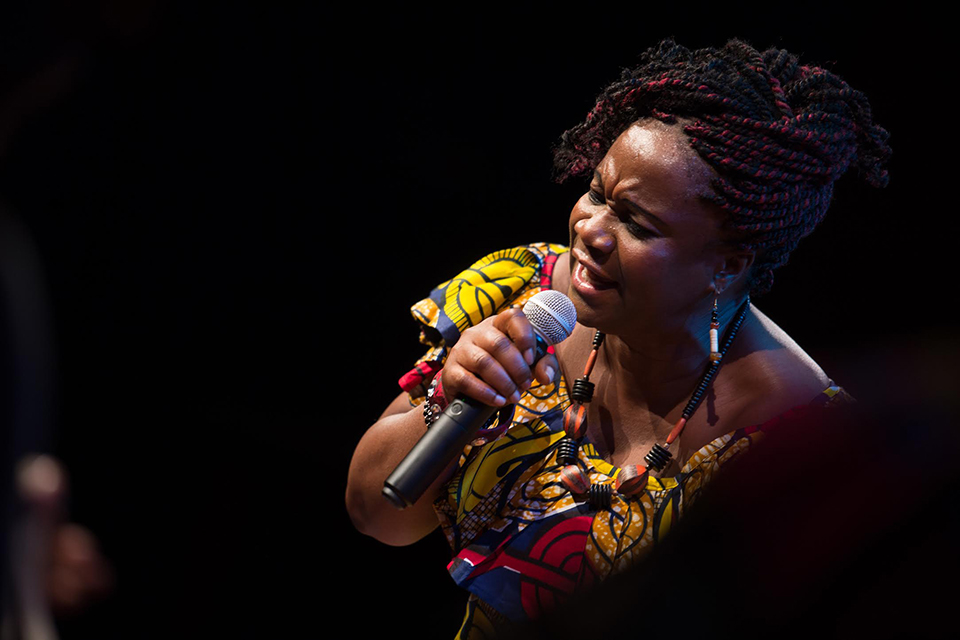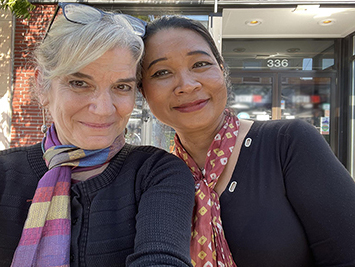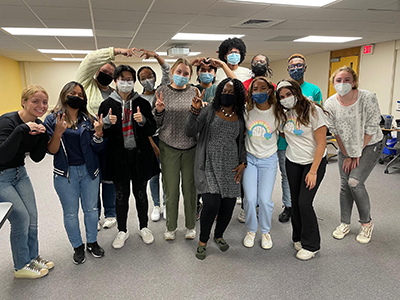Reclaiming cultures through dance: A look into Toni Shapiro-Phim’s research
Toni Shapiro-Phim has worked as a researcher, writer, curator, educator, film director, and activist following her earliest passion - dance.
 Photo/J.J. Tiziou
Photo/J.J. TiziouFatu Gayflor, artistic director of the Liberian Women's Chorus for Change, and one of the women who tells her story in the movie, Because of the War, here shown performing on stage.
Toni Shapiro-Phim, associate professor of Creativity, the Arts, and Social Transformation and co-director of the Program in Peacebuilding and the Arts, has worked as a researcher, writer, curator, educator, film director, and activist following her earliest passion - dance.
When she isn’t co-editing editing a book on dance and jewishness or teaching courses intertwined with her passion, such as Dance and Migration, she can be found researching the impact of dance within cultures, or working with particular communities, as they counter various forms of injustice with creativity and wisdom.
In her filmmaking debut, “Because of the War,” four Liberian women tell stories of the centrality of their traditional artistic practices to their survival and community-building in the aftermath of war, loss, and exile.
Shapiro-Phim spoke with BrandeisNow about her research and path to film directing.
What inspired your career path?
When I was very young, I found myself drawn to so many different things, one of them being the circus. It wasn’t the animals, but the acrobats and tight-rope walkers, and the itinerant nature of that life that I found compelling. There were several paths I could have taken, including running away to join the circus.
Things clicked for me, however, when, while working in refugee camps in Indonesia and Thailand, I was blown away by people’s prioritizing of dance in such merciless and often dangerous circumstances. In particular, it was people who had escaped from Cambodia, having survived a genocide and lost homes, livelihoods, loved ones, and whole communities, who were choosing to dance, and to make sure their children knew how to dance, even though they didn’t know what was going to happen tomorrow.
I had studied dance much of my life, starting at four years old with western modern dance, ballet, and jazz. So I was particularly drawn to what I was witnessing in terms of dance in the camps. One of the camps was in a war zone where artillery shells would rain down during performances. At those moments, dancers and the thousands watching them would run for cover. When the terror and destruction stopped, people would return to finish the show. This gave me great pause, and I desperately wanted to understand the drive to dance, and watch the dance, in the midst of that kind of vulnerability. Once I decided to return to the United States to study the relationship of dance and war, my career path started coming into focus.

Toni Shapiro-Phim with Cambodian dancer and choreographer Charya Burt, when Ms. Burt visited Waltham in June, 2022. They have known each other since 1990, when Shapiro-Phim first went to Cambodia, and are currently collaborating on an archiving project.
How does studying dance relate to your background in anthropology?
Anthropology can be defined in many ways, but it is, essentially, the study of humankind. Trying to understand why people do what they do and believe what they believe, in discrete contexts, and how they find and make meaning. The anthropology of dance is the exploration of the significance and impact of dance or structured movement systems in cultural context, including consideration of the very movement, and movement qualities, themselves.
When I lived overseas, I studied a bit of the dance in each of the places where I stayed, including Indonesia, Thailand, and, eventually, Cambodia, where I spent many years. It was helpful to have a background in dance when I started researching dance as part of my PhD studies in cultural anthropology, in part because I understood sensations that come with movement.
How can dance impact a community and make a difference?
Well, we can take the refugee camp in Thailand as an example. They were surrounded by barbed wire and armed guards, and, in at least one direction, landmines. While the United Nations and non-governmental organizations established schools and medical facilities, the Cambodian refugees in the camp, of their own accord, constructed performing art centers.
Thousands would gather and watch their fellow refugees perform. Beyond entertaining the crowds, the artists created focus and beauty in the midst of loss and inhumanity. Experiencing Cambodian dance, as performer or observer, was one way to claim a connection to a shared history and community, as well as to reaffirm dignity. Perhaps it was also a way to care for one another.
Cambodian dance, especially dance of the classical tradition, which has a long history associated with the land, spirituality, and royalty, might have been, in those circumstances, a statement against precarity as it roots people to tradition in the land they are on. Through it, inhabitants of the camp could imagine possibilities beyond the confinement and violence of their current situation.

In September of this year, Fatu Gayflor, the artistic director of the Liberian Women's Chorus for Change, and one of the women who tells her story in the movie, Because of the War, was a guest presenter in my Introduction to Creativity, the Arts, and Social Transformation course. Students watched the movie together, and then had a chance to ask Fatu questions. Fatu also taught us some movement sequences from a Liberian dance.
What inspired your directorial film debut, Because of the War?
Before I came to Brandeis, I was working at a nonprofit arts and social justice organization in Philadelphia. I got to know exceptional singers and dancers who were superstar recording and performing artists from Liberia. They had all settled in Philadelphia, with thousands of other Liberians, following back-to-back civil wars in their homeland. As part of one project we developed together, they conducted their own research within their community to identify pressing concerns. One of their findings was that Liberian women, in particular, felt isolated, given language and cultural and other barriers, and were subject, in some cases, to abuse in the home.
Four Liberian women then harnessed their fame and art to address these issues through the power of song. They formed the “Liberian Women’s Chorus for Change,” working alongside a local educational and advocacy organization, “Women Against Abuse.” I helped the Chorus secure a grant to support their work, and documented the project. My video footage became the seed for a full-length documentary, mostly about each of the women’s anti-violence and community-building work, both in West Africa and in North America.
We collaborated with an ethnomusicologist (someone who studies music in its social and cultural context) who specializes in Liberian music, and hired wonderful videographers and editors. Ultimately, we produced a film that we present sometimes at universities and film festivals, where we address anti-immigrant bias and policy, and the arts and human rights, among other things.
But our main audience has been Liberians, igniting conversations about these artist-heroes in their midst and the place of traditional expressive culture in addressing contemporary issues, even in a new country. One screening involved both the women in the film, and police officers who patrol neighborhoods where many Liberians live. They discussed the fraught relationship between police and Black immigrants, listening across differences. Those discussions have continued.
You seem to do a little bit of everything. How do you balance it all?
There are actually connections between all aspects of that “little bit of everything.” I feel very lucky that sparks of inspiration, mainly from the fabulously talented and brilliant people I have met, have led me to the next thing and the next, in my life. I’ve been careful to listen, and observe, finding ways to deepen my relationships with particular communities, and, when invited, to enter new ones respectfully, and with humility.
Categories: Arts, General, Humanities and Social Sciences, International Affairs, Student Life





